Colorado Springs, CO Pollen and Allergy Report for Summer 2023
Pollen Allergy Trends in Colorado Springs, CO
When is pollen lowest in Colorado Springs, CO?

February
Lowest month total PPM
Avg. PPM
When is pollen highest in Colorado Springs, CO?

March
Highest month total PPM
Avg. PPM
How does pollen in Colorado Springs, CO compare to Colorado?
Colorado Springs has a lower average PPM than the state of Colorado.
Colorado Springs yearly avg PPM:
Colorado yearly avg PPM:
How does pollen in Colorado Springs, CO compare to the USA?
Colorado Springs has a lower average PPM than the USA.
Colorado Springs yearly avg PPM:
USA yearly avg PPM:
Is pollen worse this year in Colorado Springs, CO?
Spring 2023 was worse than spring 2022.
Spring 2023 PPM:
Spring 2022 PPM:
Average PPM in Colorado Springs, CO


Colorado Springs, CO Pollen and Allergy Breakdown by Month
Grass
When is grass pollen highest in Colorado Springs, CO?
May has the highest grass pollen in Colorado Springs, CO with an average PPM of
When is grass pollen lowest in Colorado Springs, CO?
April has the lowest grass pollen in Colorado Springs, CO with an average PPM of
Tree
When is tree pollen highest in Colorado Springs, CO?
March has the highest tree pollen in Colorado Springs, CO with an average PPM of
When is tree pollen lowest in Colorado Springs, CO?
May has the lowest tree pollen in Colorado Springs, CO with an average PPM of
Weed
When is weed pollen highest in Colorado Springs, CO?
November has the highest weed pollen in Colorado Springs, CO with an average PPM of
When is weed pollen lowest in Colorado Springs, CO?
February has the lowest weed pollen in Colorado Springs, CO with an average PPM of
Colorado Springs, CO Pollen Monthly Breakdown by Pollen Type
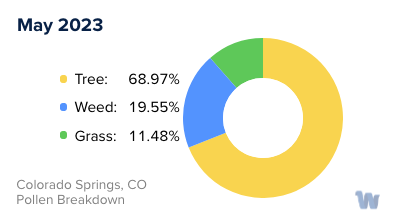
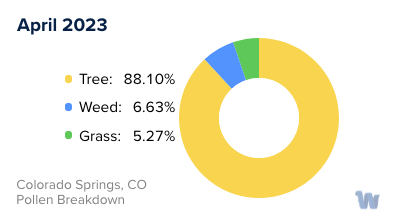




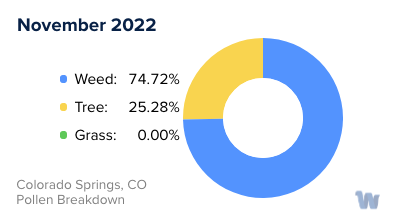
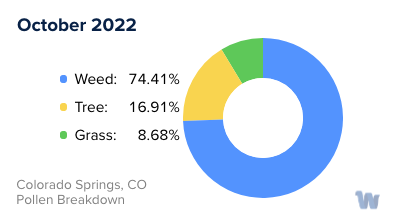

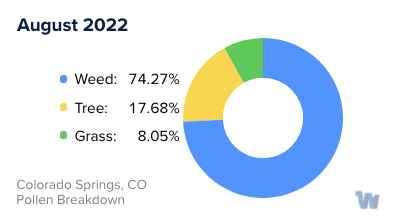

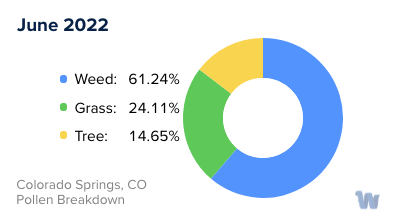

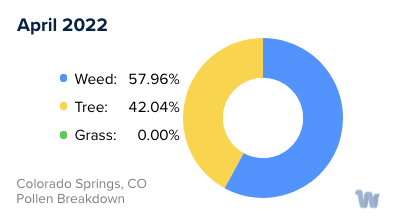


Pollen and Hay Fever in Colorado Springs, CO
Pollen allergies, commonly known as hay fever, are a significant health concern for residents of Colorado Springs, Colorado. These allergies are triggered by the inhalation of airborne pollen grains from a variety of local plants, resulting in an immune response that can cause a range of symptoms from sneezing and itchy eyes to more severe respiratory issues.
Colorado Springs has a diverse array of plant life, each contributing to the overall pollen count throughout different seasons. One of the main offenders is the tree pollen, particularly from the abundant Ponderosa Pine, which typically releases its pollen in the spring months. Cedar and Juniper are other significant contributors to tree pollen in the area.
In addition to tree pollen, grass pollen is also prevalent in Colorado Springs. The peak season for grass pollen is late spring and early summer. Common types of grasses in the area that produce allergy-inducing pollen include Kentucky Bluegrass, Timothy Grass, and Ryegrass.
As summer transitions into fall, weed pollen becomes the primary concern. Ragweed is the primary culprit, but other weed species such as Sagebrush and Russian Thistle also contribute to the pollen count.
The varying landscapes and changing seasons in Colorado Springs contribute to a near-constant presence of some form of pollen throughout most of the year. While each season brings a different type of pollen, the consistent presence of pollen in the air means that residents may experience hay fever symptoms at any time of the year. The specific type of pollen present in the air at any given time depends on the season and the types of plants that are currently in their pollination phase.
In conclusion, pollen allergies in Colorado Springs are a function of the city's diverse plant life and changing seasons, which result in different types of pollen being present in the air throughout the year. Understanding the types of pollen and their respective seasons can help residents anticipate and prepare for the challenges of living with hay fever.


